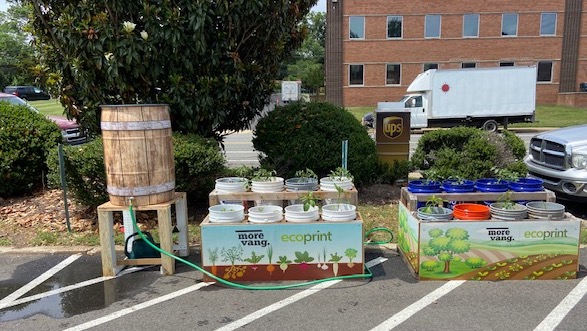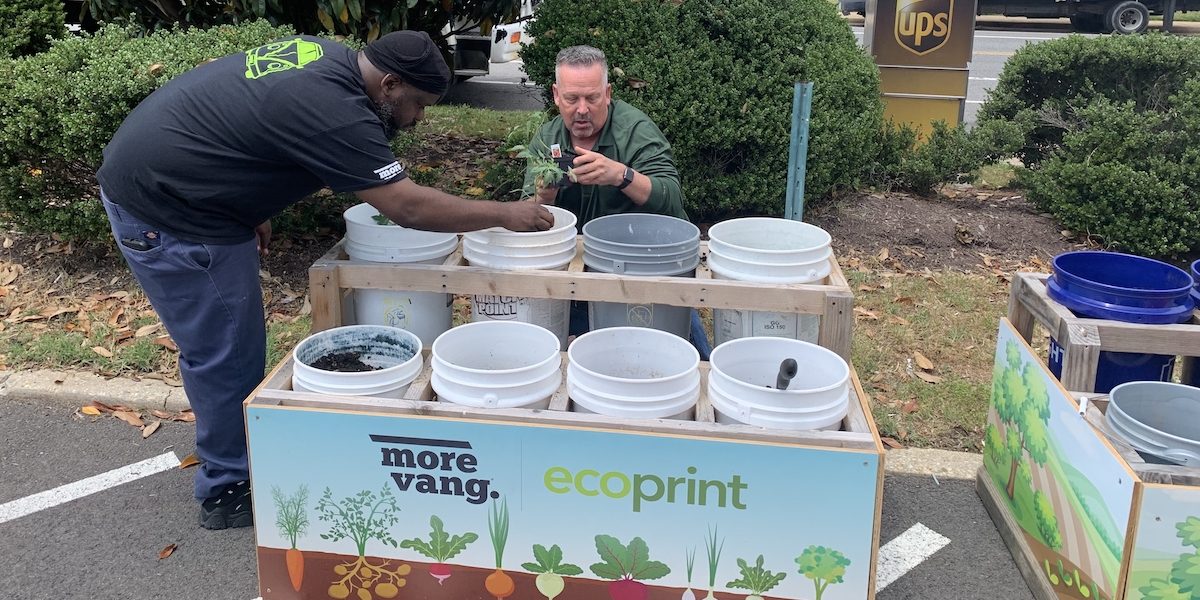We’ve learned through our partnership with local environmental groups that urban development and hardscapes (i.e., parking lots and roads) affect everything from polluted stormwater runoff to dwindling habitats for birds and insects. As part of our ongoing sustainability efforts, we decided to make the most eco-friendly use of the space we have by installing a bucket garden in a portion of our parking lot.
Gardening is a great way to improve the air we breathe, and growing our own food minimizes our carbon footprint. Plants also help reduce noise pollution and support an entire ecosystem. Our little garden will blossom over the summer and eventually yield a variety of different produce, including grape tomatoes, La Roma tomatoes, Anaheim hot peppers, sweet bell peppers, sweet banana peppers, and long red cayenne hot peppers. We look forward to sharing the fruits (or in this case, vegetables) of our labor with our staff as we all return to the office.

So, what exactly is a bucket garden?
If you have a little bit of space (even a small terrace will do!) and some patience, you can create your own garden that has a positive impact on the environment. Repurposed buckets create the perfect growing conditions and have many practical and environmental benefits, including:
- Save on water
- No space constraints
- Ideal for novice gardeners
- Garden indoors or outdoors
- Enjoy no-till gardening
- Save on fertilizers
- Easier pest control
This kind of garden is especially great if you’re short on space or if you rent your home and aren’t allowed to plant a traditional garden. You don’t have to dig up your yard or build large planters, though you may choose to build a stand like ours (more info on that below). Another benefit of a bucket garden is that you can move it around and, if you decide gardening just isn’t your thing, you can easily get rid of it and move on.
Each five-gallon bucket can house one vegetable plant and perhaps two or three smaller herbs. You can grow as many different vegetables as you have buckets! They’re easy to move around, maximize sunlight exposure, and come fall, you can easily protect your plants from early frosts.

How to set up your own bucket garden
- Build your stand.
If you plan to have more than a few buckets in your garden, you might want to keep them organized in a stand. We built ours, which holds eight standard five-gallon buckets, to keep our garden buckets neatly stacked and in order. We built our stand using standard 2x4s. If you intend to keep your bucket garden for more than a couple of years, we recommend using pressure treated lumber. Click here for detailed plans. - Select and prepare your buckets.
Five-gallon buckets make terrific containers for a number of vegetables. Not only do they hold just enough potting soil for roots to thrive, but they don’t take up a lot of room on a crowded patio or deck. You can find five-gallon buckets at Home Depot or Lowe’s for around $4 a piece, or you can simply repurpose other buckets, as we elected to do. Be sure to drill holes in the bottom of each bucket for drainage. - Add your compost or potting soil.
For best results, go with an even mixture of potting soil, compost, and peat moss. You can even make your own potting soil. Just be sure not to use garden soil or topsoil, as those can compact in the bucket and inhibit your plant growth. - Choose your favorite vegetables.
Some vegetables that grow well in buckets include tomatoes, cucumbers, squash, eggplant, carrots, beets, onions, radishes, peppers, beans, and herbs. - Water, observe and enjoy!
Be sure to water your plants whenever the soil is dry. To conserve water, you can use a rain barrel to capture rain water and then use that to water your garden.
Happy gardening!
Sustainably,
Bobby Firestein

